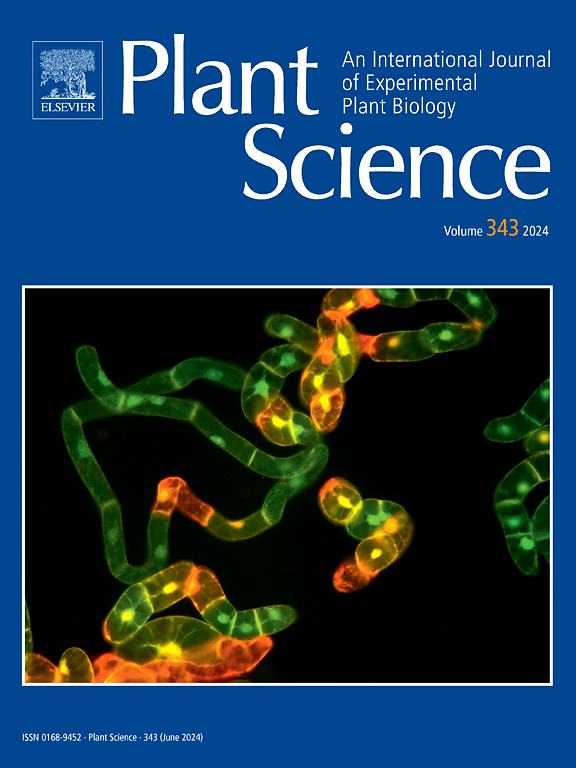The cell death-inducing protein BcPlp1 from Botrytis cinerea contributes to pathogenicity and modulates plant resistance
IF 4.2
2区 生物学
Q2 BIOCHEMISTRY & MOLECULAR BIOLOGY
引用次数: 0
Abstract
Botrytis cinerea is a necrotrophic plant pathogen fungus with a broad host range, causing grey mould and rot diseases in many important crops, leading to significant economic losses in agriculture. Cell death-inducing proteins (CDIPs) secreted by necrotrophic phytopathogens promote plant tissue death and play important roles in infection. However, the mechanisms by which CDIPs induce cell death in B. cinerea-plants interactions remain unclear. Here, we demonstrate that the B. cinerea CDIP BcPlp1 is secreted into the plant apoplast where it induces cell death. BcPlp1 is a cysteine-rich protein, and four out of the 8 cysteine residues and a conserved N-terminal α-helix structure are essential for its cell death-inducing activity. A purified GST-tagged BcPlp1 fusion protein triggered cell death in multiple plant species, up-regulated expression of defense-related genes and enhanced plant resistance to B. cinerea. Additionally, the cell death-inducing activity of BcPlp1 was mediated by leucine-rich repeat (LRR) receptor-like kinases BAK1 and SOBIR1. Furthermore, BcPlp1 was not necessary for colony morphology, conidial production, growth rate, and stress tolerance. Although deletion of BcPlp1 did not affect virulence, its overexpression led to larger disease lesion, highlighting its contribution to B. cinerea pathogenicity when upregulated.
来自灰葡萄孢(Botrytis cinerea)的细胞死亡诱导蛋白BcPlp1参与致病性并调节植物抗性
灰霉病菌(Botrytis cinerea)是一种具有广泛寄主范围的坏死性植物病原真菌,可引起许多重要作物的灰霉病和腐烂病,给农业造成重大经济损失。坏死性植物病原菌分泌的细胞死亡诱导蛋白(CDIPs)可促进植物组织死亡,并在侵染过程中发挥重要作用。然而,CDIPs 在 B. cinerea 与植物相互作用中诱导细胞死亡的机制仍不清楚。在这里,我们证明了 B. cinerea CDIP BcPlp1 被分泌到植物的细胞质中,并在那里诱导细胞死亡。BcPlp1 是一种富含半胱氨酸的蛋白质,8 个半胱氨酸残基中的 4 个残基和保守的 N 端 α 螺旋结构对其诱导细胞死亡的活性至关重要。纯化的 GST 标记 BcPlp1 融合蛋白可诱导多种植物的细胞死亡,上调防御相关基因的表达,增强植物对 B. cinerea 的抗性。此外,BcPlp1 诱导细胞死亡的活性是由富含亮氨酸重复(LRR)的受体样激酶 BAK1 和 SOBIR1 介导的。此外,BcPlp1 对菌落形态、分生孢子的产生、生长速度和抗逆性都不是必需的。虽然 BcPlp1 的缺失不会影响毒力,但其过度表达会导致更大的病变,这突出表明了其在上调时对 B. cinerea 致病性的贡献。
本文章由计算机程序翻译,如有差异,请以英文原文为准。
求助全文
约1分钟内获得全文
求助全文
来源期刊

Plant Science
生物-生化与分子生物学
CiteScore
9.10
自引率
1.90%
发文量
322
审稿时长
33 days
期刊介绍:
Plant Science will publish in the minimum of time, research manuscripts as well as commissioned reviews and commentaries recommended by its referees in all areas of experimental plant biology with emphasis in the broad areas of genomics, proteomics, biochemistry (including enzymology), physiology, cell biology, development, genetics, functional plant breeding, systems biology and the interaction of plants with the environment.
Manuscripts for full consideration should be written concisely and essentially as a final report. The main criterion for publication is that the manuscript must contain original and significant insights that lead to a better understanding of fundamental plant biology. Papers centering on plant cell culture should be of interest to a wide audience and methods employed result in a substantial improvement over existing established techniques and approaches. Methods papers are welcome only when the technique(s) described is novel or provides a major advancement of established protocols.
 求助内容:
求助内容: 应助结果提醒方式:
应助结果提醒方式:


